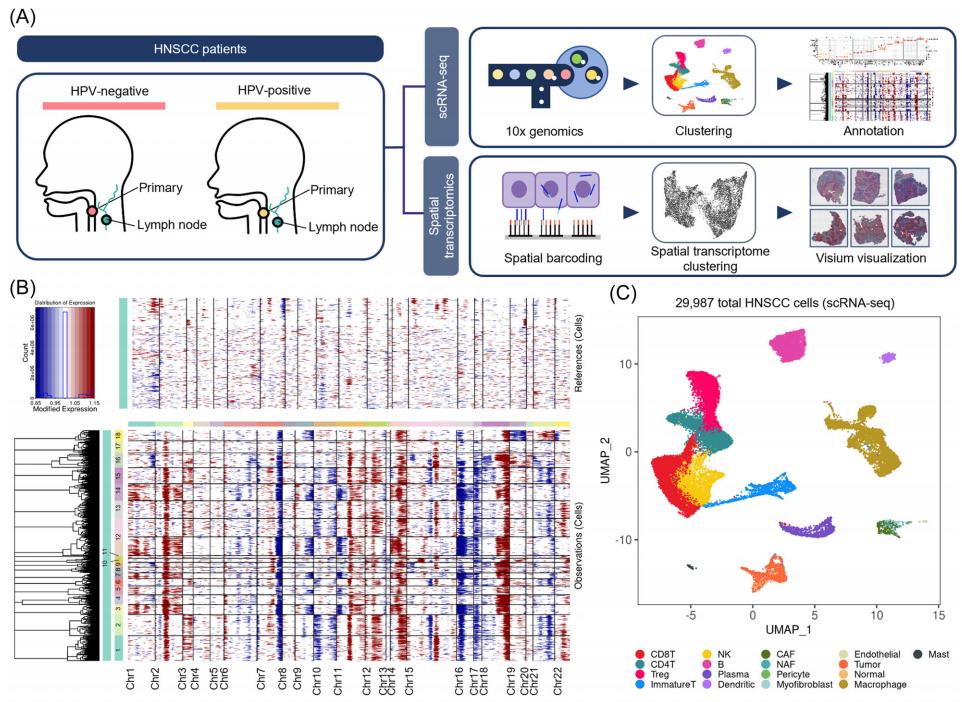Head and neck squamous cell carcinoma (HNSCC) is a type of cancer that affects the mucosa of the oral cavity, nasal cavity, and throat. Its occurrence is often associated with tobacco exposure, alcohol abuse, and viral infections. Currently, researchers are unclear about the association between human papillomavirus (HPV) infection status and molecular characteristics of HNSCC.
Recently, in a research report titled "Deciphering head and neck cancer microenvironment: Single-cell and spatial transcriptomics reveals human papillomavirus-associated differences" published in the international journal Journal of Medical Virology, scientists from Pusan National University and other institutions analyzed the cell diversity and molecular properties in the complex tumor microenvironment of HNSCC under HPV iResearcher Kim said that the incidence of HNSCC has increased significantly in recent years. However, scientists know very little about the key role that HPV infection plays in the pathogenesis of HNSCC and the specific molecular mechanisms behind its association with HNSCC.
In this study, researchers used samples from HPV-negative and HPV-positive patients to perform single-cell RNA analysis (a gene sequencing technology) and spatial transcriptomics analysis (ST, an advanced molecular analysis technology). Related analyzes were also performed on samples of primary tumors and lymph node metastases (LNMTs). The results of in-depth research may provide a significant picture of the complex association between HPV infection and the occurrence of HNSCC. In the case of HPV-positive HNSCC, immune cells can actively participate in tumorigenesis, and the molecular characteristics of HNSCC will be significantly affected by the status of HPV infection, rather than the actual location of the tumor.

Figure 1. Single‐cell transcriptional profiling of HNSCC patients. (Lee H, et al., 2024)
RNA sequencing analysis and ST analysis results showed that the pyruvate kinase muscle (PKM) gene plays an important role in the cancer stem cell-like population of lymph node metastasis tumors in HPV-negative tissues. In HPV-negative HNSCC cell lines, PKM gene expression is often consistent. And this also reveals its important role in the ability to form spheroidal structures, which has been studied by genetic knockout of the PKM2 gene. Interestingly, the researchers also confirmed the presence of ectopic lymphoid structures such as these during ST analysis of HPV-positive patients.
So the researchers wanted to investigate further and focus on the key process of angiogenesis (the pathway by which new blood vessels form). They performed single-cell RNA and ST analysis on HPV-negative patients and found that Ephrin-A (EPHA2) may be mainly involved in angiogenesis and cell migration pathways. Kim said, "Our findings on the PKM and EPHA2 molecular pathways may serve as therapeutic targets to inhibit the growth and spread of HNSCC cancer cells." In addition, the tumor microenvironment can also be affected by HPV infection status. Therefore, researchers may be able to develop precision medicine methods to combat HNSCC.
| Cat.No. | Product Name | Price |
|---|---|---|
| CSC-RH0170M | Humanized EPHA2 Murine Tumor Cell Line | Inquiry |
| CSC-RT0549 | Human EPHA2 Knockout Cell Line-HeLa | Inquiry |
| CSC-RT1878 | EPHA2 Knockout Cell Line-HCT116 | Inquiry |
| AD05520Z | Human EPHA2 adenoviral particles | Inquiry |
| LV00270Z | Human EPHA2 lentiviral particles | Inquiry |
| CLKO-0054 | EPHA2 KO Cell Lysate-HeLa | Inquiry |
| CLKO-1732 | EPHA2 KO Cell Lysate-HCT116 | Inquiry |
| CLOE-0312 | Human EPHA2 HEK293 Cell Lysate | Inquiry |
| CLOE-0313 | Human EPHA2 Insect Cell Lysate | Inquiry |
| CLOE-2600 | Mouse Epha2 HEK293 Cell Lysate | Inquiry |
In summary, this study enhances scientists' understanding of the HNSCC microenvironment, which may be expected to help guide the development of HNSCC therapies, especially in inhibiting cancer cell growth and migration. Therefore, HPV infection may be regarded as a criterion for formulating treatment strategies, thereby promoting scientists to develop precise individualized treatment strategies for different patients.
Reference
Lee H, et al. Deciphering head and neck cancer microenvironment: Single-cell and spatial transcriptomics reveals human papillomavirus-associated differences. Journal of Medical Virology, 2024, 96(1): e29386.

